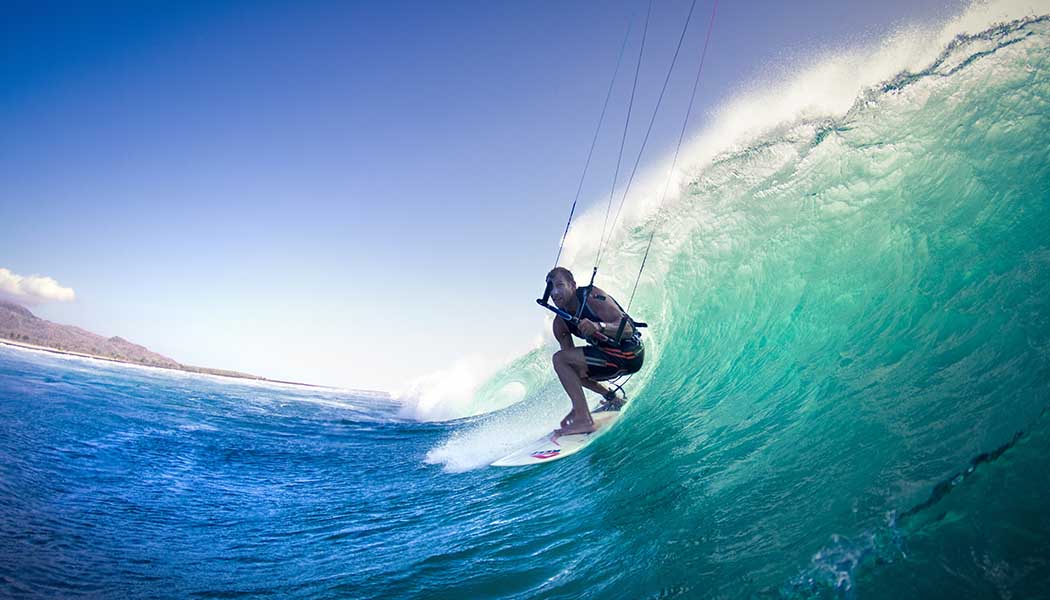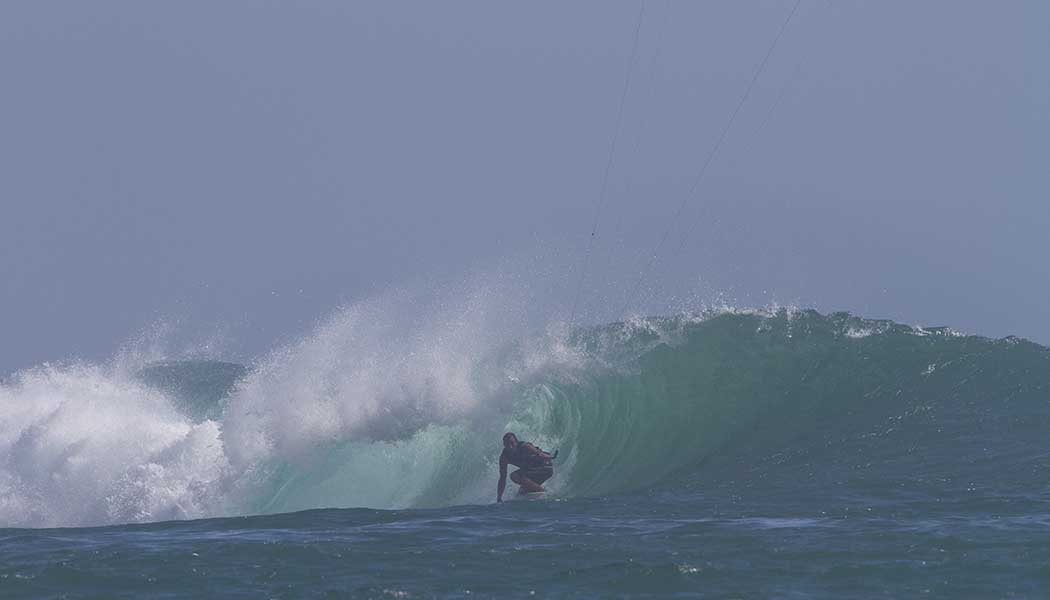‘Good direction, strong wind and waves. Put those three elements together and you can have magic for sure.’ Bali’s kite surfers enjoy their best days in Bali.
Words: Stephanie Mee. Photos: Jason Wolcot.
FOR ordinary folk, summer in Bali means clear sunny days on the beach or in the rice fields, but for kitesurfers, this is the time to get seriously amped. As soon as the side-shore winds start wailing, these guys and gals grab their gear and head out for epic fast-paced rides along glassy expanses and killer barrels too blown out for surfers but befitting for kiters. Although relatively new in Bali and the world at large, kiting is progressing at a rapid clip and gaining international notoriety for its extreme versatility and fun factor.
The birth of kiting as we know it today can be traced back to the 1800s when a pioneering soul by the name of George Pocock got the brilliant idea to propel ships across the water with kites that were attached by a four-line system, a system that is still used in modern kitesurfing today. Over the years many enterprising individuals developed new equipment and pushed the sport forward, but it wasn’t until the 1980s that the kitesurfing took on its modern form and was popularised by radical thinkers in Maui and California.
By the 1990s, kitesurfing had exploded on the international scene, and Giancarlo Avancini (AKA Jankie) was one of the devotees. Jankie arrived in Bali in the late ‘90s, and like so many do, fell in love with the place and a local beauty, so he decided to settle here. In 1999, he opened the Blue Oasis Beach Club, and two years later began teaching kitesurfing at the club, making it the first and only kitesurfing school in Bali.
In the beginning there were only a few kiters hitting up the spray, but Jankie saw the potential that the sport had here in Bali. He says: “Kitesurfing is unique in that it combines many other water sports. You get the speed of water skiing, the acrobatic moves of wakeboarding, the precise curves on the waves like surfers, and amazing jumps that literally get you flying.”
It was precisely this flexibility that drew in adventurous enthusiasts much like surfers to swells, and longtime Bali denizen, Sky Rama, was among them.
“I come from Maui, the birthplace and mecca of kitesurfing, but ironically it was Bali that broke me in about six years ago,” says Sky. “I got up on my second lesson, and once I got going, the rush was like being a little kid again. That’s when I knew it was for me.
“I was born into surfing, so that absolutely helped, but with surfing I felt like had I reached a plateau. With kitesurfing there is so much more freedom. You can go out on the ocean and play here and there. And we don’t need huge waves, because the wind creates the speed and the speed is what makes it fun.
“I’ve been out with surfers who are surfing a break and by the time they catch one wave, I’ve already been on my fifth or sixth wave. We can catch any wave we want. Plus, you don’t have to wait to paddle and you don’t have to sit in a big crowd and fight for your waves.”
In recent years, riders like Sky have seen a mind-boggling increase in the technology of kitesurfing equipment, which has propelled the sport to unprecedented levels.
“The safety systems on the kites are light years ahead of what they were five or six years ago.” Sky says. “Now it’s very easy to detach everything if you have to, and easier to launch from tight areas. For the general public, it’s so much safer now.
“On another level, the technicality of the riders has also advanced. We kite with a lot of pros and when we watch the progression, it’s amazing. You get guys riding strapless and doing 360s on the waves with the kite, and when you see it live, you’re just like ‘How is that possible?’ We’re definitely breaking the limits for sure.”
Watch Sky and his crew ride, or any kitesurfing video, and you may get the impression that kitesurfing is no more difficult than strapping yourself in and slicing through the surf like a knife through butter. However, like all extreme sports, there is an element of danger involved.
“Watching experienced riders flying effortlessly on their boards and shredding havoc on the waves makes it look like it’s easy and anyone can do it, but kitesurfing is a sport to be taken with extreme respect,” says Jankie. “The kites are extremely powerful and can easily become a danger to yourself and to others. Your kite can drag you down the beach like a wild horse or throw you into the air like a twig.”
Sky says: “One of the most dangerous things that can happen is you drop the kite and a wave hits the kite while you’re still hooked in. Then the kite starts riding with the waves and drags you along, so you’re going at the same speed that the wave is going and practically drowning. That’s the hairiest – getting worked into the surf with the kite. It’s like being pulled by a boat and it keeps pulling, and you can’t breathe.
“That’s why you should never try this by yourself. It’s not like surfing where you can just grab a board and go out. With kitesurfing you absolutely have to take a lesson. You have to learn about the equipment, the winds, how to self-rescue, and how to take in your kite. Very few people I know were self-taught, and the few that were got seriously hurt.”
Besides safety and skills, kitesurfers have to be aware of the on-water etiquette and learn how to share their space with others in the ocean, particularly surfers. In Bali this has been an especially poignant issue.
“We were kiting at Batu Bolong way before there was anyone even surfing there,” says Sky. “Even four years ago, there were hardly any surfers there. That was our spot. But slowly all the schools moved in and it got so crowded that we got squeezed out. And they kept saying, ‘Go up the beach there’, and we were like ‘We want to ride waves too’.
“We know that surfing’s been around a lot longer than kitesurfing – I know that because I’m a surfer myself – and we’re not trying to plant our flag and or step on anyone’s toes. Teaching is their business, and we respect that. But on the other hand, we feel that we just want a little understanding on our side. Kitesurfing is something relatively new, and people are often afraid of things they don’t understand.
“It’s different for us because we know that we’re in control, and if the surfers are kind enough to allow us to ride the waves they can’t catch, then we can all be safe and have fun. And it goes both ways – if I’m out and see that a surfer can catch a wave, I let them go for it, because I know can catch any wave. I try to be cool about it, because I want the sport to grow in a positive light and keep things going in the right direction.”
Like Jankie, Sky believes that kitesurfing will only get bigger in Bali and around Indonesia.
“Vietnam is known for its great kitesurfing conditions, but the waves in Bali are much nicer to ride,” he says.
“In fact, I would choose the best days in Bali over the best days in Vietnam for sure. The boys and I also go to a few of the outer islands here that we would rank as some of the best in the world. So Indonesia is actually one of the best places for kitesurfing when the season is on.
“I think that this year we’ll have more kiters than ever, because last year was just amazing. People were just showing up out of nowhere to our local spot, and we were like ‘Who’s this?’ ‘Ya, come on out and join us’. I also believe more locals will pick up the sport because the interest is there.”
As for tips for those looking to break into the sport, Sky says: “You have to be patient with kitesurfing because it’s not like you can pick a board up, run into the ocean and stand up in the first hour. I had a surf school before and we guaranteed that in the first hour you’d be surfing and standing, otherwise you would get your money back. You won’t find that in kite surfing – it’s going to take a bit of time. But stick with it, because once you get it, it’s one of the coolest things since ice cream.”
KITESURFING IN BALI: THE LOWDOWN
THE SEASON
The dry season between May and September is the best time to grab the gusts in Bali. During this time, the easterly trade winds are not extremely strong, but they can be consistent. The windiest months are June, July and August.
THE KITES
Because Bali tends to have light winds, bigger kites are better. Depending on your weight, the kite should be anywhere from 12 to 15 metres.
THE SPOTS
In Bali the best place for beginner kitesurfers is at Kite Beach in Sanur, also called Pantai Pura Mertasari. The huge lagoon here is perfect for newbies, as the water is calm and the wind intensity is not so strong.
For more advanced riders, Canggu has a number of spots that get world-class wind and waves on the right days. However, the area is not recommended for beginners, as there are a number of hazards including big waves, currents, rocks and crowded surf breaks.
Some of the most consistent winds can be found in Bali’s wild west in Menjangan Bay. Here the winds are strong and the water is smooth. A local kiter by the name of Iwan has recently set up a kitesurfing camp here called Wild West Beach Camp with rustic bungalows and epic days on offer.
THE SCHOOLS AND SHOPS
Bali Kitesurfing School is the original kitesurfing school on the island, and it is run by a group of passionate and patient Balinese kitesurfers. They use the latest and best equipment on the market, all lessons are one-on-one and the instructors will follow you at all times in the water in a motorised boat.
Rip Curl School of Surf is an international kitesurfing school that is associated with International Kite Organisation (IKO). They offer three levels of lessons, and provide rash shirts, shorts, wetsuits, impact vests, booties, helmets, seating harnesses, bars, kites and boards with every lesson.
Kite & Surf Bali – The Pro Shop is the only kitesurfing shop in Bali, and a haven of top-notch equipment and world-class brands like Cabrinha, Ozone, Jimmy Lewis and Flying Object.





































